Sichuan Tourism: Two visits to Wuhou Temple and Du Fu Cottage in Chengdu (Photo)
Regarding Chengdu's Wuhou Temple and Du Fu Cottage, the reporter has had two unforgettable visits in more than 20 years. Although the order of the two visits is different, they have their own different profound memories.
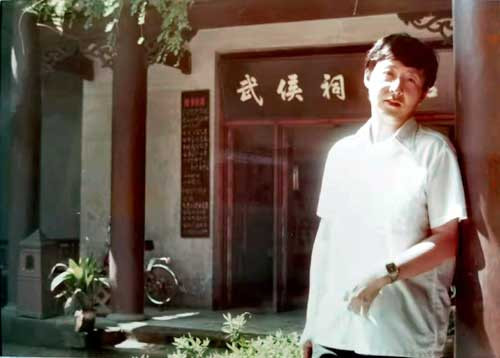
Photo taken at the Wuhou Temple in 1990 (Photo: Li Ping)
I remember that the first time I came to Chengdu was June 30, 1990 in the last century. At that time, in order to thank Laojiao in Luzhou, Sichuan for his strong support for the recording of a group of songs for the 11th Asian Games including "Asian Heroes", we passed through Chengdu on the way to Luzhou. Under the arrangement of Tan Dexiang, then director of CCTV's Sichuan Reporter Station, Comrade Xiang Shijian from the reporter station accompanied me and my colleague Li Ping to the Du Fu Cottage and Wuhou Temple to pay our respects.

Photo taken at the Wuhou Temple in 1990 (Photo: Li Ping)
At that time, what impressed me most was the ticket to Luzhou by taking the domestically produced Yunqi from Shuangliu Airport. The plane with only a few dozen seats was only 65 yuan. The flight from Chengdu to Luzhou is about 45 minutes. This is also the first time a reporter has taken a plane.

First photo taken at Shuangliu Airport (Photo: Li Ping)
Many years have passed, and now when it comes to Wuhou Temple, reporters are familiar with it as if it were a few treasures. At present, there are as many as seven Wuhou Temple distributed across the country, namely Chengdu Wuhou Temple, Mian County Wuhou Temple, Shaanxi Province, Nanyang Wuhou Temple, Gulongzhong Wuhou Temple, Xiangyang City Wuhou Temple, Fengjie Baidi City, Chongqing, Baoshan Wuhou Temple, Yunnan Wuhou Temple and Qishan Wuhou Temple, Li County, Gansu Province. Among them, the reporter has visited all five except Xiangyang, Hubei Province and Li County, Gansu Province. Therefore, as the first time, Chengdu's largest Wuhou Temple can visit it for the second time. The reporter felt that it was very meaningful.

Photo taken by Wuhou Temple in Mian County (Photo: Ma Ziping)
On September 16, 2021, the reporter took the opportunity of participating in the free travel on the first day of the "Top of Sichuan" itinerary recommended by Manager Shen Hui of Ctrip Travel. The reporter and group members Wang Jue, Ma Xiuyu, Li Jun and others took an online taxi from the Jincheng Hotel where they stayed for only 15.60 yuan, and arrived at the Wuci Museum in Wuhou District, Chengdu in ten minutes. Nowadays, Chengdu's fast transportation is really convenient.

Memorial Stone of the Holy Land of the Three Kingdoms (Photo: Ma Xiuyu)
When I came back to Wuhou Temple 21 years later, I had a vague memory of everything except Liu Bei's tomb. There is a commemorative stone of the "Holy Land of the Three Kingdoms" inscribed by Mr. Qigong at the gate. I don't think there was any back then. So after leaving a group photo, the reporter and his party walked into the Wuhou Temple and began to pay homage.

Photo taken during the Second Tour of Wuhou Temple (Photo: Ma Xiuyu)
It was built in the first year of Zhang Wu (221). It was originally a special temple in memory of Zhuge Liang, also known as Kongming Temple, Zhuge Temple, Prime Minister Temple, etc., and was later merged into the only temple in China where monarch and minister worshiped together. Its most famous memorial site for Zhuge Liang, Liu Bei and the heroes of the Shu Han Dynasty, and the Museum of Remains of the Three Kingdoms, enjoys the reputation of the "Holy Land of the Three Kingdoms" and is worthy of its name.

The gate of Wuhou Temple (Photo: Feng Ganyong)
Wuhou Temple is a carrier of people's affirmation and praise for the spirit of Zhuge Liang, the prime minister of Shu Han Dynasty, who "dedicated himself to death". It is also the source of the relics of the Three Kingdoms. It consists of four parts: Han Zhaolie Temple, Wuhou Temple, Huiling Temple, and Sanyi Temple. It belongs to Chengdu Wuhou Temple Museum. Cultural heritage protection area.

Wuhou Temple Courtyard (Photo: Feng Ganyong)
Over the years, reporters have visited many Wuhou shrines across the country, and when they visited here again, they deeply felt the size of this Wuhou Temple in Chengdu, which covers an area of 37000 square meters and a construction area of 9200 square meters. Compared with other Wuhou shrines, it is really second to none.

Walking into the Wuhou Temple (Photo: Feng Ganyong)
When tourists enter the Wuhou Temple, people's eyes are filled with lush cypresses, heavy temples, strict layout, and solemn scenes one after another.

Second Gate of Wuhou Temple (Photo: Feng Ganyong)
The layout of the entire Wuhou Temple is rigorous and orderly. The main building's main gate, second gate, Liu Bei Hall, passing hall, and Wuhou Temple are strictly arranged on a central axis from south to north. On the west side is Liu Bei Cemetery Huiling and its buildings.

Yong Road leading to Zhuge Hall (Photo: Feng Ganyong)
The second door to Liu Bei Hall and the east and west halls, and the passing hall to Zhuge Liang Hall and the east and west rooms form two groups of four-in-one building structures. There are garden attractions and ancillary buildings on both sides of the axis building. Walking into the Han Zhaole Temple, you can see six stone tablets standing on a road from the main gate to the second gate.

The Red Wall Trail in Huiling (Photo: Feng Ganyong)
It is a pity that this trip coincided with the renovation of Liu Bei's tomb, known in history as "Huiling", so we couldn't see it. Historically, Zhuge Liang personally chose the precious land to bury Liu Bei here. "Annals of the Three Kingdoms·Biography of the First Lord" records: "In August, Huiling was buried." According to the "posthumous law","loving the people and loving peace is called 'Hui'", hence the name Liu Bei's tomb is called" Huiling ".

Corner outside Huiling (Photo: Feng Ganyong)
Liu Bei's two wives, Gan and Wu, were also buried together in the tomb. In front of Liu Bei's tomb, there is a stone tablet "Mausoleum of Emperor Zhaolie of the Han Dynasty" erected during the Qianlong period of the Qing Dynasty. The wooden plaque building of the tomb consists of a curtain wall, a fence door, a sacred road, a bedroom hall, etc.

Exhibition of the Chronicles of the Three Kingdoms in the Temple (Photo: Feng Ganyong)
There is a smaller Shinto in front of the mausoleum built in the Qing Dynasty. Huiling, like the main buildings of Wuhou Temple, faces north to south, and is immediately adjacent to the west side of Han Zhaolie Temple and Wuhou Temple. It is connected to the Wuhou Temple by red walls and roads.

Statue of civil officials and generals (Photo: Feng Ganyong)
On both sides of the red-walled corridor leading to Zhuge Liangdian are golden statues of many generals of the Three Kingdoms, including the Five Tiger Generals. They are majestic and lifelike on both sides. This is not found in other Wuhou Temples, reflecting the unique characteristics of Chengdu Wuhou Temple. The coexistence of monarch and minister.

Sitting portrait of Zhuge Liang (Photo: Feng Ganyong)
Arriving at Zhuge Liang's Hall, I saw a sitting statue of Zhuge Liang decorated with gold and clay sculpture. On the left side is Zhuge Liang's son Zhuge Zhan, and on the right side is Zhuge Liang's grandson Zhuge Shang. There are three bronze drums in front of the statue. They were cast before the sixth century AD. Legend has it that they were used during the Southern Expedition of Yi and barbarians.

Yue Feishu's stone carving of graduation table (Photo: Feng Ganyong)
There are many stone carvings embedded in the back wall of the main hall. On the east wall is Zhuge Liang's "Longzhong Dui" written by contemporary calligrapher Shen Yinmo, which expresses the ambition of "taking care of the world three times and opening up the hearts of old ministers"; on the west wall is Zhuge Liang's "Graduation Table" written by Yue Fei, a famous general of the Song Dynasty and a national hero who "faithfully serves the country". The famous sentence "Work hard and die before you die" has been sung down through the ages, and the awe-inspiring righteousness of loyalty and persistence pervades the rainbow. There are many pairs of plaques inside and outside the hall, all of which are praises and memories of Zhuge Liang.

Sanyi Temple (Photo: Feng Ganyong)
Passing through Zhuge Liang Hall, the last thing you see is Sanyi Temple. It was originally named Sanyi Temple and was built by Sichuan Governor Zheng Jiaolin in the early years of Kangxi of the Qing Dynasty. It was destroyed by a fire caused by burning incense in 1784. It was rebuilt in 1787 and fully renovated in 1842.

Portrait of Liu Bei in Sanyi Temple (Photo: Feng Ganyong)
The buildings and plaques seen now are mainly relics from the Daoguang period. The building is of a mixed structure with an area of 569 square meters and has four buildings and five halls. It is a large scale. Later, it gradually collapsed, leaving a few buildings intact. In 1981, it was announced as a city-level cultural relic protection unit in Chengdu City. In 1998, due to urban construction needs, Sanyi Temple was relocated from Tidu Street to Wuhou Temple.

Jinli Ancient Street (Photo: Feng Ganyong)
From Sanyi Temple further behind is the back door of Wuhou Temple, separated by a wall is Jinli Ancient Street. This place was famous throughout the country during the Three Kingdoms Period. Today's Jinli is part of the Wuhou Temple Museum. Visitors can visit the ancient street after visiting the Wuhou Temple.

Ancient streets and alleys (Photo: Feng Ganyong)
Jinli Ancient Street is 550 meters long. Relying on the Wuhou Temple in Chengdu, it takes the spirit of the Qin, Han and Three Kingdoms as its soul, the style of the Ming and Qing Dynasties as its exterior, and the folk customs and folk customs of western Sichuan as its content, expanding the extension of the culture of the Three Kingdoms.

Corner of Jinli Ancient Street (Photo: Feng Ganyong)
Walking along this street, people can deeply feel the full flavor of Sichuan. Jinli embodies the essence of Chengdu life: there are tea houses, inns, restaurants, bars, stage, flavored snacks, handicrafts, and local specialties, fully demonstrating the unique charm of Sichuan folk customs.

Photo taken during his first visit to Du Fu Cottage (Photo: Li Ping)
The reporters and his party ended their visit to the Wuhou Temple and took a taxi to Du Fu Cottage again. The two places are not too far apart. It only cost 16 yuan, but it still takes more than ten minutes to reach the Du Fu Caotang Museum located on Qinghua Road, Qingyang District, Chengdu. This is the first batch of national key cultural relics protection units, the first batch of national first-level museums, and the national key protection unit for ancient books. It is the largest, best-preserved, most well-known and most distinctive site of Du Fu's whereabouts in China.

Head of Du Fu Cottage (Photo: Wang Jue)
21 years later, I came to Du Fu Cottage again to pay homage to it. Du Fu, this great poet saint, left the world too many precious works handed down from generation to generation, which are admired by people from generation to generation. Unfortunately, I really have no memories of my first visit to Du Fu's Cottage.

Walking into Du Fu Cottage (Photo: Feng Ganyong)
Du Fu Cottage covers an area of nearly 300 acres, completely retaining the architectural pattern during the renovation and expansion in the 13th year of Hongzhi of the Ming Dynasty (AD 1500) and the 16th year of Jiaqing of the Qing Dynasty (AD 1811). The building is simple and elegant, and the garden is quiet and beautiful. Du Fu lived here for nearly four years and wrote more than 240 poems. It is a holy place in the history of Chinese literature. Du Fu Cottage Museum is now divided into several major areas: the former site of the Cottage in the cultural relics and scenic spots area, the Plum Garden in the garden and scenic spots and the Caotang Temple in the service area.

Statue of Du Fu (Photo: Feng Ganyong)
Walking into the former site of the Cottage, you can see Zhaobi, main entrance, Daxie, Poetry and History Hall, Chaimen, and Gongbu Temple arranged on a central axis, with symmetrical corridors and other ancillary buildings on both sides. There are flowing water lingering between them, connected by small bridges and hidden by bamboo trees, making it both solemn and solemn, simple and elegant, yet deep, quiet, beautiful and clear. On the east side of the Temple of the Ministry of Works is the "Shaoling Cottage" stele pavilion, symbolizing Du Fu's thatched thatched

Scenery of Du Fu's Cottage (Photo: Feng Ganyong)
Entering the main entrance of Du Fu Cottage is the first building on the center axis of its main memorial building complex. The word "Cottage" on the main entrance plaque was inscribed by Prince Guo Yunli, the seventeen sons of Emperor Kangxi of the Qing Dynasty and the younger brother of Emperor Yongzheng. There is also a couplet hanging on both sides of the door,"Wanli Bridge West House, Baihuatan North Village", which is derived from Du Fu's poem "Huaijinshui Juzhi Two Poems". These two poems accurately point out the geographical location of the Cottage at that time and where the Cottage is today.

Cottage Dayatang (Photo: Feng Ganyong)
Beyond the main entrance is Dayaitang, which was officially opened in 2002. It was originally the Daxiong Hall of Caotang Temple, so the reporter first came here 21 years ago and had no impression of it. The three characters "Dayaitang" on the plaque on the door now belong to the famous Tang Dynasty calligrapher Yan Zhenqing.

Huanhua Temple in the Cottage (Photo: Feng Ganyong)
The Dayang Hall displays the largest area of large-scale colored glaze inlaid lacquer murals in China and 12 sculptures of famous poets from past dynasties, vividly showing the life of Du Fu and the development history of Chinese classical poetry. The basic display in the museum,"The Sage of Poetry Written for the Future", won the Best Creative Award of the fifth "Top Ten National Exhibition and Exhibition Works".

Caotang Shadow Wall (Photo: Feng Ganyong)
To be honest, what impressed Du Fu's Cottage most when he came to his Cottage was the two words "Cottage" and shadow wall in porcelain characters. Now, I feel particularly cordial when I see this scenery called "Flower Path". The origin of this scenic spot stems from the fact that in front of Du Fu's hut, there was a path with flowers and trees on both sides. He once wrote in his poem: "The flower path has never been swept by guests, and the tent door has now been opened for you."

Photo taken on the Flower Path of the Second Tour of the Cottage
Today's flower path is a red-walled path connecting the Du Fu Cottage Memorial Building Complex and the original Caotang Temple. At the end of the flower path is the "Cottage Shadow Wall". Yin Zhoushanpei of Sichuan Quanye Road in the late Qing Dynasty used blue and white broken porcelain to insert the word "Cottage" here, damaged several times and restored several times. When Chairman Mao inspected the Cottage in 1958, he stared at these two words for a long time. As one of the symbols of the Cottage, the reporter once again left precious pictures here.

Flower Path (Photo: Wang Jue)
Stroll along the red wall path not far away is the thatched hut scenic spot. I really can't remember the memories of that time, but the "thatched scenic spot" that Du Fu Cottage Museum restored and rebuilt in 1997 based on Du Fu's poems and the pattern of the Ming Dynasty recreates the pastoral style of the poet's former residence and creates a strong poetic atmosphere., leaving a deep impression on visitors.
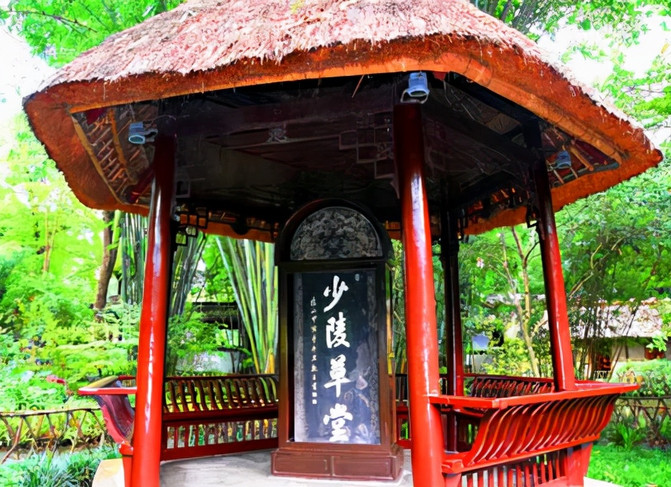
Shaoling Cottage (Photo: Feng Ganyong)
The Shaoling Stele Pavilion in the "Maowu Scenic Area" is one of the most representative buildings in Du Fu's Cottage. It is a pavilion with a thatched roof. There is a stone tablet in the tree engraved with the four characters "Shaoling Cottage". The writing power is strong and the writing is beautiful. It is written by Prince Guo. In the 12th year of Yongzheng (1734 AD), Prince Guo sent Dalai to Tibet. After passing through Chengdu, he paid a special visit to the Cottage and left this handwriting. People often use it as a symbol of a hut.

Bronze statue of Du Fu (Photo: Feng Ganyong)
Continue wandering and arrive at the Daxie Scenic Area of Du Fu Cottage. "Xi" means official office, that is, the place where local officials worked in ancient times. Du Fu's career was bumpy all his life and he was never allowed to be reused. When the Cottage was rebuilt in the 16th year of Jiaqing of the Qing Dynasty, it was considered that Du Fu had once been an official and should have an office place, so the big office was named after this. The bronze statue of Du Fu in the center of the mansion is the work of Mr. Qian Shaowu, a famous sculptor in my country. It is an open-hall building and the second building on the central axis.

Photo taken at the 1990-Year Poetry and History Hall (Photo: Li Ping)
Shishi Hall is the third building on the central axis and the main building. This is also the place where the reporter once took photos here, but apart from the pictures from that year, other impressions have disappeared. Historically, the more than 1400 poems left by Du Fu truly and vividly present the picture of social life in the Tang Dynasty before and after the "Anshi Rebellion", reflecting the history of the Tang Dynasty from prosperity to decline.
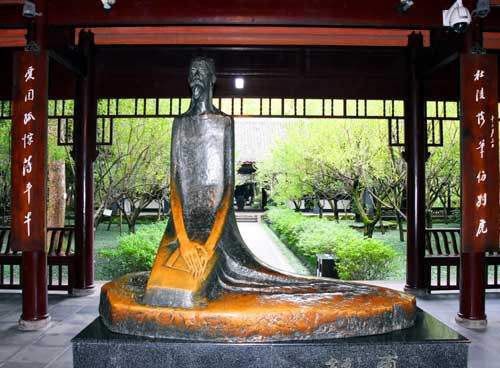
Statue of Du Fu (Photo: Feng Ganyong)
Du Fu was respected by later generations as the "Poetry Saint", and his poems were called "Poetry History", hence the name "Poetry History Hall". In the center of the hall is a statue of Du Fu portrayed in a realistic manner by Mr. Liu Kaiqu, a famous sculptor in my country.

Cottage Chaimen (Photo: Feng Ganyong)
The Chaimen in Du Fu's Cottage is the fourth building on the central axis and the smallest and simplest building. It was originally the courtyard gate built by Du Fu when he built the Cottage. Because of its low simplicity, the poet named it so. The word "Chai Gate" on the plaque on the door was written by the famous painter Pan Tianshou.

Cottage Wanfo Building (Photo: Feng Ganyong)
Continue to wander to the Wanfo Tower, which stands in the nanmu forest to the east of the thatched cottage and was rebuilt in 2005. It restores the style of the historical and cultural city of Chengdu with "Chongli Pavilion in the east and Wanfo Tower in the west". Looking into the distance from the fence and enjoying a panoramic view of the beautiful scenery, it is another landmark building and a new highlight of cultural tourism. Unfortunately, it was not open that day and could not climb the building to look into the distance. It could only be exterior.
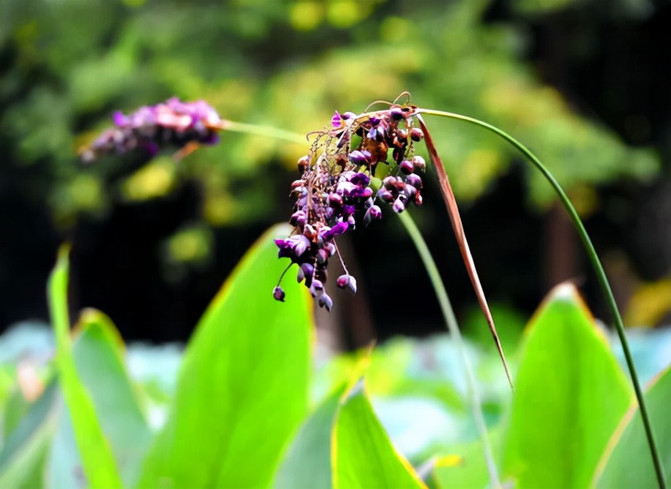
Xiaojing of the Plum Garden in the Caotang (Photo: Feng Ganyong)
The Plum Garden is located in the northwest corner of Du Fu's Cottage, covering an area of dozens of acres. It was originally a private garden and was also placed under the management of the Cottage after the founding of the People's Republic of China. Passing the Poetry and History Hall, turning westward, passing through the water sill, and passing through the Moon Cave Gate, you will find the Plum Garden in front of you. At this time, when people stand outside the Yuedong Gate, they can see a four-story brick tower standing on the lake, and a curved bridge spans the lake. The tower is named "List Pavilion." Take the meaning of the sentence "A glance at the mountains and small" in Du Fu's poem "Wangyue".

Corner of Meiyuan (Photo: Feng Ganyong)
The shadow of the tower reflects the water surface, forming a wonderful echo with the curved bridge, while the Moon Cave Gate becomes the viewing frame. With its just right cut, the tower, bridge, lake, flowers and trees all form a beautiful picture. No wonder many tourists use this as the background and leave their own shadows behind.
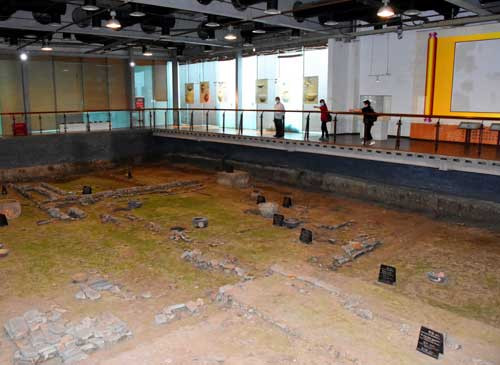
Tang Dynasty Ruins Exhibition Hall (Photo: Wang Jue)
Finally, we came to the Tang Dynasty Ruins Exhibition Hall located to the northeast of the Cottage. This is also a scenic spot that I haven't seen during my first visit to the Cottage. At the end of 2001, a large area of Tang Dynasty life sites and a number of Tang Dynasty cultural relics were excavated in the thatched house. They greatly enriched the historical and cultural connotation of Du Fu's thatched house, confirmed Du Fu's description of the living environment and living scenes, and confirmed the historical fact that Du Fu's thatched house has been rebuilt from generation to generation on its original site, which not only clarified the dispute over the location of Caotang Temple in ancient and modern times, but also increased the historical significance of Du Fu's thatched house.
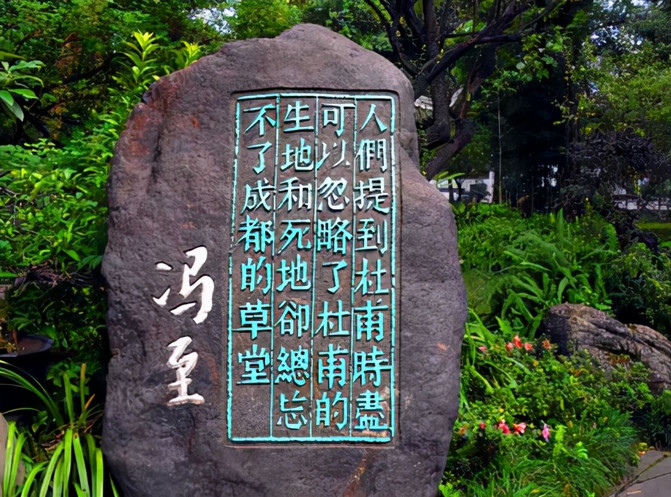
Writer Feng Zhi's inscription stone (Photo: Wang Jue)
Nowadays, wandering in the garden, you can still see inscriptions and poems written by the famous modern writer Feng Zhi and the famous contemporary writer Yu Guangzhong and others, which undoubtedly adds a unique landscape to this classical cultural garden.

Ancient Books Restoration Exhibition Hall (Photo: Feng Ganyong)
According to reports, Chengdu Du Fu Cottage Museum currently contains more than 30,000 volumes of various materials and more than 2000 pieces of cultural relics. These include fine printed copies, photocopies, manuscripts and modern printed copies of Du Fu's poems in the Song, Yuan, Ming and Qing dynasties, as well as foreign translations in 15 languages and more than 120 Chinese printed copies published in Korea and Japan. It is the place with the richest and best preserved collection of Du Fu's creations throughout his life.

Xiaojing of the Moon Gate (Photo: Feng Ganyong)
The "Du Fu Poetic Paintings" collected by Du Fu's Cottage have become a special painting category in the Chinese painting world, and are collected by many major museums across the country. Modern masters Qi Baishi, Xu Beihong, Fu Baoshi, Pan Tianshou, Liu Haisu, Wu Zuoren, Li Kuchan, Wang Xuetao and others also created masterpieces of different styles based on the meaning of Du's poems and paintings. Du Fu Cottage in Chengdu is famous all over the world for its poetry, and thanks to its poetry, it will be celebrated in future generations.

Photo taken by Du Fu's Cottage (Photo: Ma Xiuyu)
Twenty-one years later, the reporter visited Chengdu Wuhou Temple and Du Fu Cottage for the second time. It was full of rewards, and once again he left an unforgettable and beautiful memory in his heart. (Photo and text: Feng Ganyong)
Previous Article:Choose a day to go on a summer vacation with your best friend and your children, looking for greenery and coolness
Next Article:Coco takes you to experience the charming land of abundance
